Research on Pulsed Jet Flow Control without External Energy in a Blade Cascade
Abstract
:1. Introduction
2. The Novel Concept of Pulsed Jet without External Energy Injection
2.1. Analysis of Typical Unsteady Flow Control Schemes
2.2. Introduction of the Novel Concept of Pulsed Jet without External Energy Injection
3. Numerical Simulation and Analysis of Flow Control in Cascade by a Pulsed Jet without External Energy Injection
3.1. Numerical and Flow Field Analysis (POD) Method
3.1.1. Numerical Method
3.1.2. Flow Field Analysis Method (POD)
3.2. Numerical Simulation and POD Analysis of Unsteady Flow in the Cascade without Flow Control
3.3. Numerical Simulation and POD Analysis of Unsteady Flow in the Cascade with Steady and Pulsed Jet Flow Control
4. Experimental Verification of Pulsed Jet Flow Control in Cascades
4.1. Test and Measurement System
4.2. Experimental Analysis of Flow Characteristics in the Cascade without and with Flow Control
5. Conclusions
- (1)
- A novel pulsed jet flow control method without external energy injection is brought up in this paper. The new concept employs a micro switch to control the slot in the blade on and off to generate the pulsed jet of a certain frequency by the pressure difference between the pressure side and suction side of the blade. The corresponding cascade model is established for numerical and experimental studies.
- (2)
- Large eddy simulation is held referring to this cascade with and without pulsed jet flow control on it. The numerical simulations show that when the frequency of pulsed jet is approximate to that of separation vortex, the control effect is more visible.
- (3)
- The POD method is used to analyze the complex unsteady flow field. The different POD modes represent the different scale flow structures. Based on conducted research, the first mode represents the structure of time-averaged flow, and the second and third modes together represent the separation vortices. Other modes represent other more small-scale and complex vortex structures.
- (4)
- Through the POD method, the main function of the unsteady pulsed jet control is seen to reallocate the kinetic energy of each mode, and enhancing or weakening certain modes. Based on the valid parameters of the pulsed jet, the kinetic energy of the higher modes will be transferred to first mode (time-averaged flow), using second and third modes (separation vortices), making flow field more simple and orderly.
- (5)
- The corresponding experiment results show that when the frequency of the pulsed jet is approximate to that of separation vortex, the loss coefficient of the average total pressure decreases to a minimum (about 5.5% in the experiment). This verifies the numerical simulation and the feasibility of this novel pulsed jet control without external energy injection.
Acknowledgments
Author Contributions
Conflicts of Interest
References
- Rivir, R.B.; Bons, J.P.; Lake, J.P. Passive and Active Control of Separation in Gas Turbines; AIAA Paper 2000-2235; AIAA: Reston, VA, USA, 2000. [Google Scholar]
- Kerrebrock, J.L.; Reijnen, D.P.; Zimimsky, W.S.; Smilg, L.M. Aspirate Compressor; ASME 97-T-525; ASME: New York, NY, USA, 1997. [Google Scholar]
- Kirtley, K.R.; Graziosi, P.P.; Wood, P.P.; Beacher, B.B.; Shin, H.W. Design and Test of an Ultralow Solidity Flow-Controlled Compressor Stator. ASME J. Turbomach. 2004, 127, 689–698. [Google Scholar] [CrossRef]
- Greenblatt, D.; Wygnanski, I.J. The Control of Flow Separation by Periodic Excitation. Prog. Aerosp. Sci. 2000, 36, 487–545. [Google Scholar] [CrossRef]
- You, D.; Moin, P. Active control of flow separation over an airfoil using synthetic jets. J. Fluids Struct. 2008, 24, 1349–1357. [Google Scholar] [CrossRef]
- Collis, S.S.; Joslin, R.D.; Seifert, A.; Theofilis, V. Issues in active flow control: Theory, control, simulation, and experiment. Prog. Aerosp. Sci. 2004, 40, 237–289. [Google Scholar] [CrossRef]
- Gmelin, C.; Zander, V.; Hecklau, M.; Thiele, F.; Nitsche, W.; Huppertz, A.; Swoboda, M. Active Flow Control Concepts on a Highly Loaded Subsonic Compressor Cascade Resume of Experimental and Numerical Results; ASME GT2011-46468; ASME: New York, NY, USA, 2011. [Google Scholar]
- Zheng, X.Q.; Zhou, X.B.; Zhou, S. Control of Unsteady Separated Flows inside Axial Compressors by Synthetic Jet; AIAA Paper 2005-870; AIAA: Reston, VA, USA, 2005. [Google Scholar]
- Matejka, M.; Safarik, P.; Popelka, L.; Nozicka, J. Influence of Active Methods of Flow Control on Compressor Blade Cascade Flow; ASME GT2008-51109; ASME: New York, NY, USA, 2008. [Google Scholar]
- Culley, D.E.; Bright, M.M.; Prahst, P.S.; Strazisar, A.J. Active Flow Separation Control of a Stator Vane Using Embedded Injection in a Multistage Compressor Experiment. J. Turbomach. 2004, 126, 24–34. [Google Scholar] [CrossRef]
- Hecklau, M.; Wiederhold, O.; Zander, V.; King, R.; Nitsche, W.; Huppertz, A.; Swoboda, M. Active Separation Control with Pulsed Jets in a Critically Loaded Compressor Cascade. AIAA J. 2011, 49, 1729–1739. [Google Scholar] [CrossRef]
- Luca, L.D.; Girfoglio, M.; Chiatto, M.; Coppola, G. Scaling properties of resonant cavities driven by piezo-electric actuators. Sens. Actuators A Phys. 2016, 247, 465–474. [Google Scholar] [CrossRef]
- Chiatto, M.; Capuano, F.; Coppola, G.; De Luca, L. Lem characterization of synthetic jet actuators driven by piezoelectric element: A review. Sensors 2017, 17, 1216. [Google Scholar] [CrossRef] [PubMed]
- Schuler, B.J.; Kerrebrock, J.L.; Merchant, A.A.; Drela, M.; Adamczyk, J. Design, Analysis, Fabrication and Test of an Aspirated Fan Stage. In Proceedings of the ASME Turbo Expo 2000: Power for Land, Sea, and Air, Munich, Germany, 8–11 May 2000. [Google Scholar]
- Larosiliere, L.M.; Wood, J.R.; Hathaway, M.D.; Medd, A.J.; Dang, T.Q. Aerodynamic Design Study of Advanced Multistage Axial Compressor; National Aeronautics and Space Administration, Langley Research Center: Hampton, VA, USA, 2002.
- Schuler, B.J.; Kerrebrock, J.L.; Merchant, A. Experimental Investigation of a Transonic Aspirated Compressor. J. Turbomach. 2005, 127, 340–348. [Google Scholar] [CrossRef]
- Culley, D.E.; Braunscheidel, E.P.; Bright, M.M. Impulsive Injection for Compressor Stator Separation Control; AIAA Paper 2005-3633; AIAA: Reston, VA, USA, 2005. [Google Scholar]
- Wygnanski, I. The Variables Affecting the Control of Separation by Periodic Excitation. In Proceedings of the 2rd AIAA Flow Control Conference, Portland, OR, USA, 28 June–1 July 2004. [Google Scholar]
- Zheng, X.Q.; Zhou, X.B.; Zhou, S. Investigation on a Type of Flow Control to Weaken Unsteady Separated Flows by Unsteady Excitation in Axial Flow Compressors. J. Turbomach. 2005, 127, 489–496. [Google Scholar] [CrossRef]
- Huang, G.P.; Lu, W.Y.; Zhu, J.F.; Fu, X.; Wang, J.C. A nonlinear dynamic model for unsteady separated flow control and its mechanism analysis. J. Fluid Mech. 2017, 826, 942–974. [Google Scholar] [CrossRef]
- Rowley, C.W.; Dawson, S.T.M. Model reduction for flow analysis and control. Annu. Rev. Fluid Mech. 2017, 49, 387–417. [Google Scholar] [CrossRef]
- Lumley, J.L. The structure of inhomogeneous turbulent flows. In Atmospheric Turbulence and Wave Propagation; Publishing House Nauka: Moscow, Russia, 1967; pp. 166–178. [Google Scholar]
- Aubry, N.; Holmes, P.; Lumley, J.L. The dynamic of coherent structures in the wall region of a turbulent boundary layer. J. Fluid Mech. 1988, 192, 115–173. [Google Scholar] [CrossRef]
- Ma, X.; Karniadakis, G. A low-dimensional model for simulating three-dimensional cylinder flow. J. Fluid Mech. 2002, 458, 181–190. [Google Scholar] [CrossRef]
- Cizmas, P.; Palacios, A. Proper orthogonal decomposition of turbine rotor–stator interaction. J. Propuls. Power 2003, 19, 268–281. [Google Scholar] [CrossRef]
- Fan, C.L.; Li, X.W. Proper orthogonal decomposition method for flow analysis of multi-element airfoil. J. Shanghai Univ. 2012, 18, 76–82. [Google Scholar]
- Feng, L.H.; Wang, J.J.; Pan, C. Proper orthogonal decomposition analysis of vortex dynamics of a circular cylinder under synthetic jet control. Phys. Fluids 2011, 23, 014106. [Google Scholar] [CrossRef]
- Chatterjee, A. An introduction to the proper orthogonal decomposition. Curr. Sci. Comput. Sci. 2000, 78, 809–817. [Google Scholar]
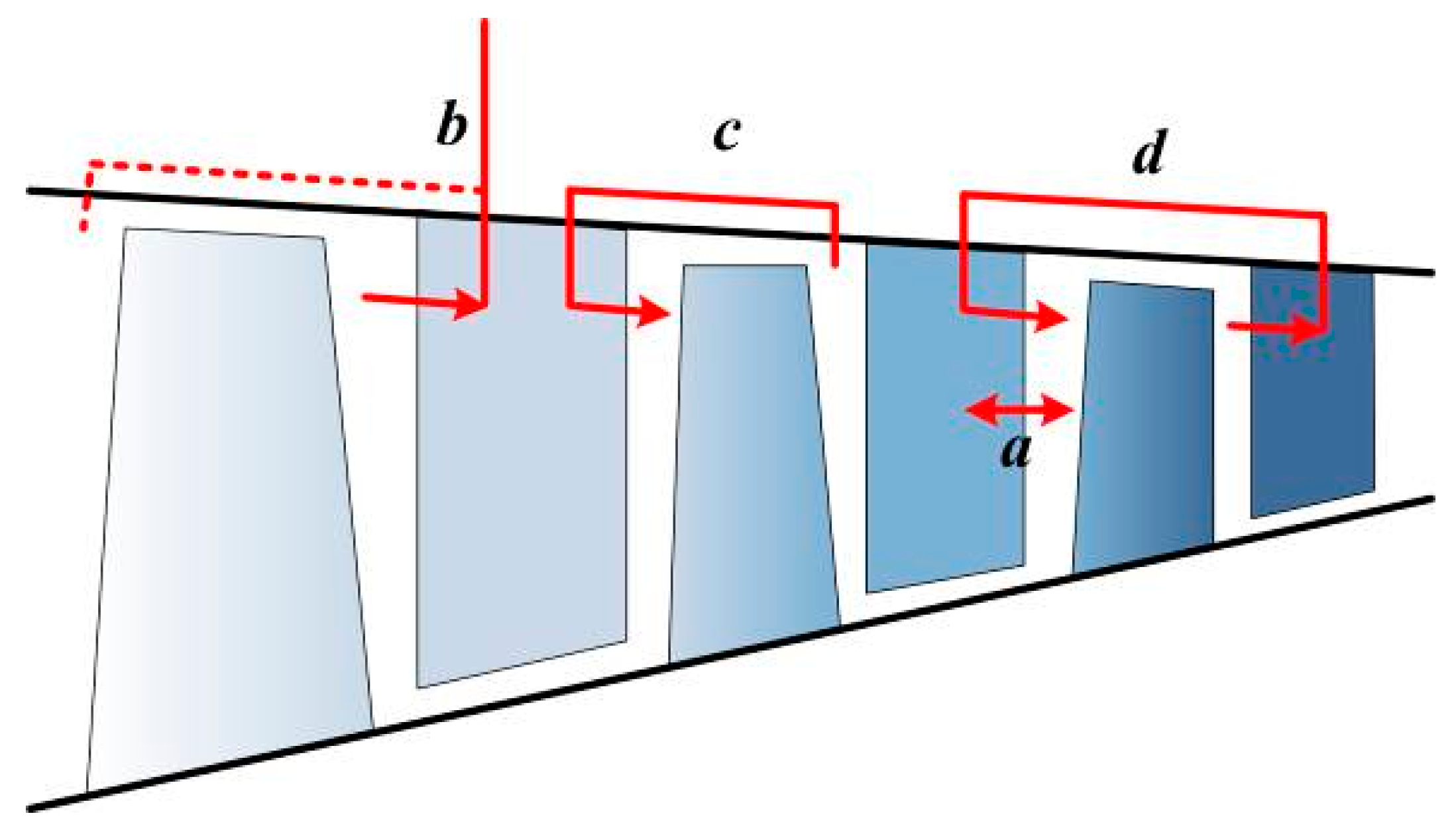
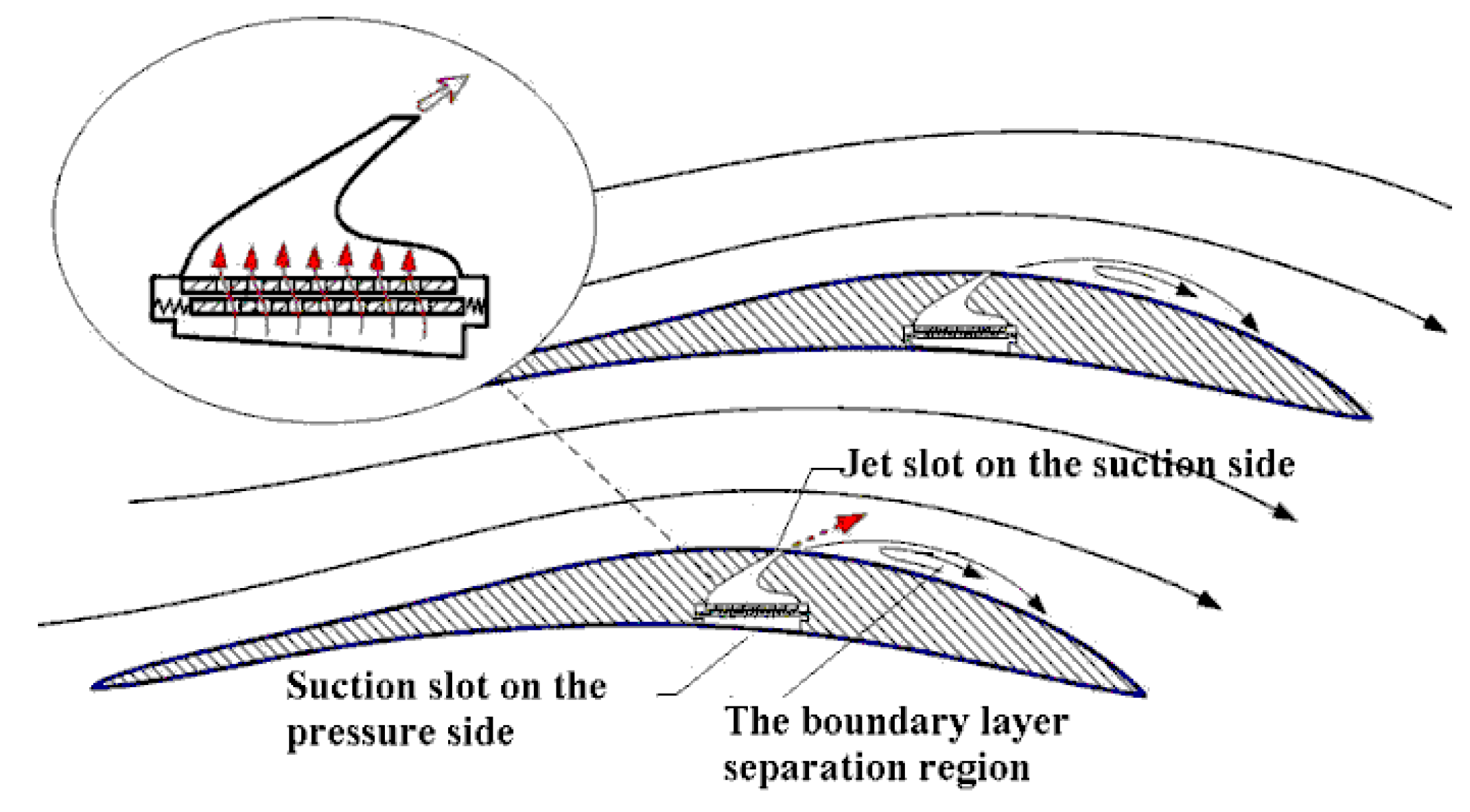
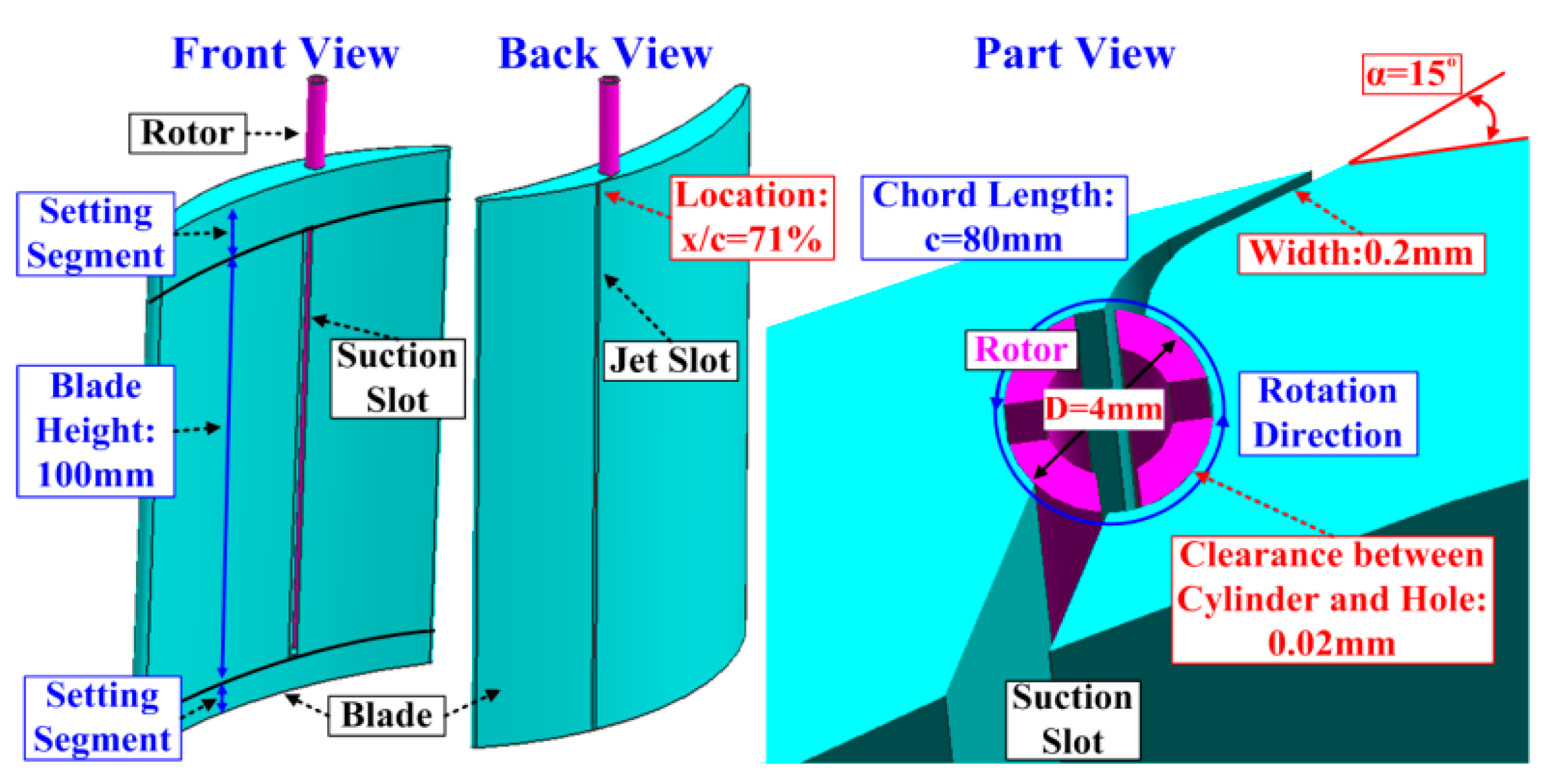

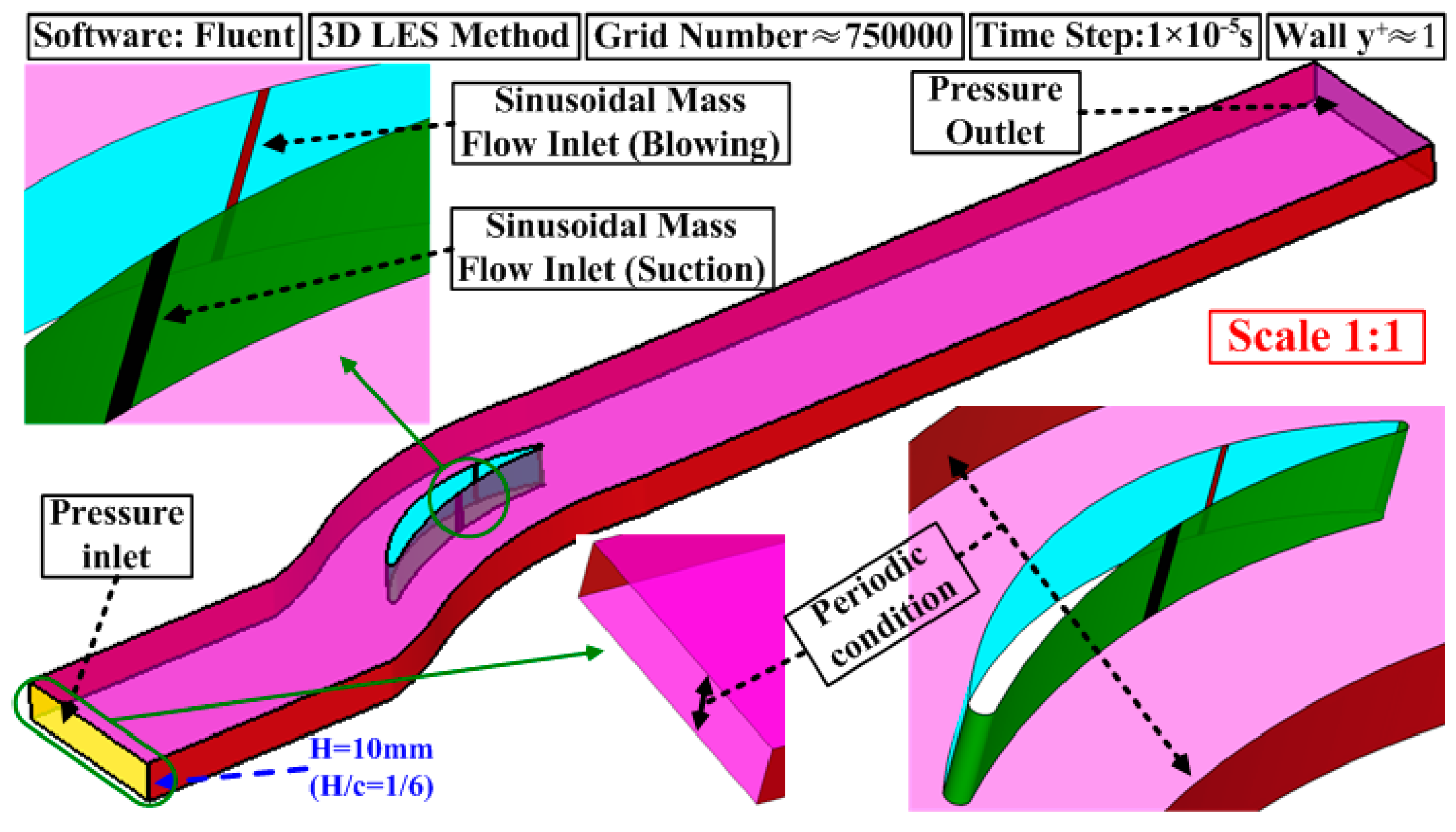
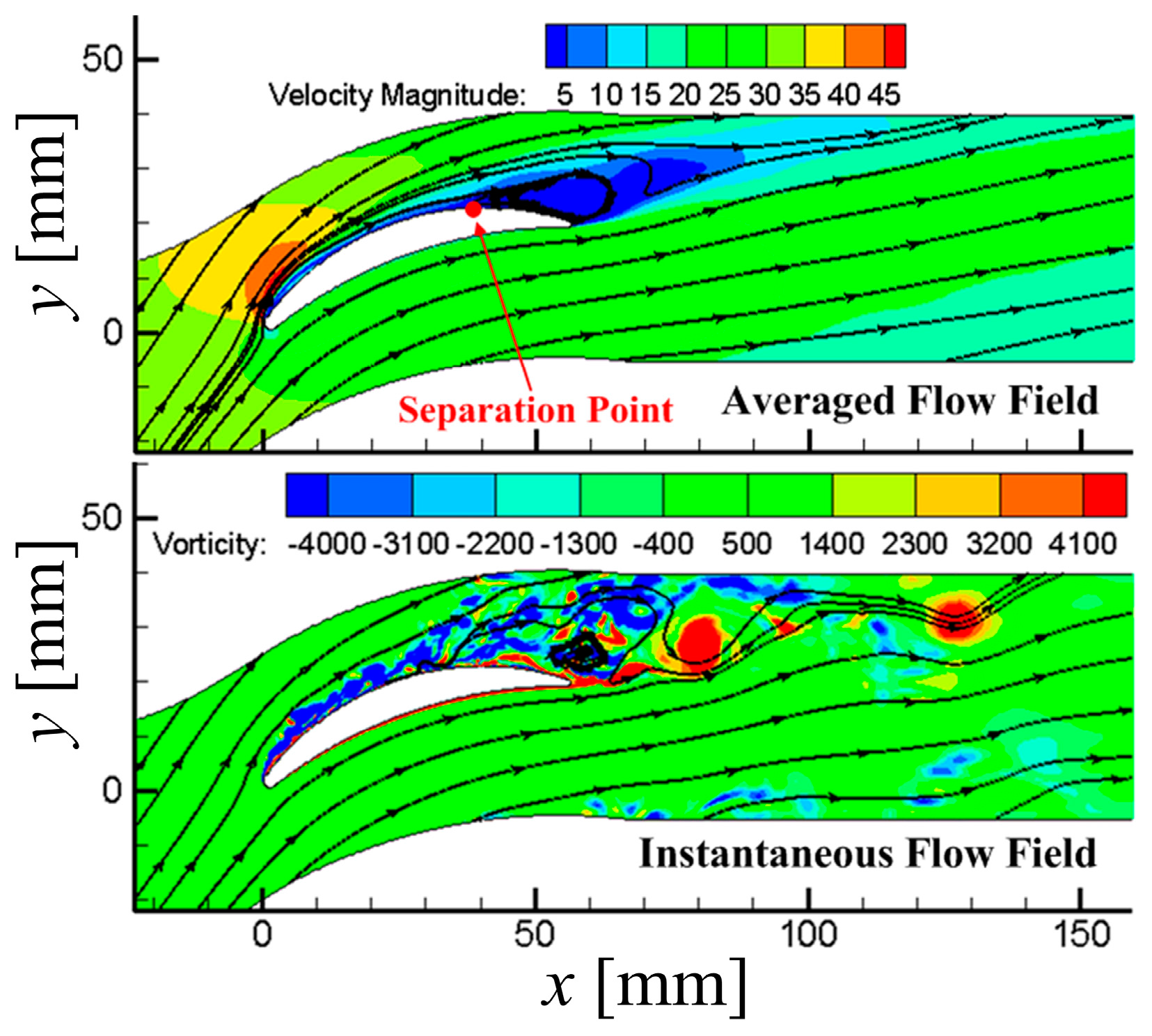
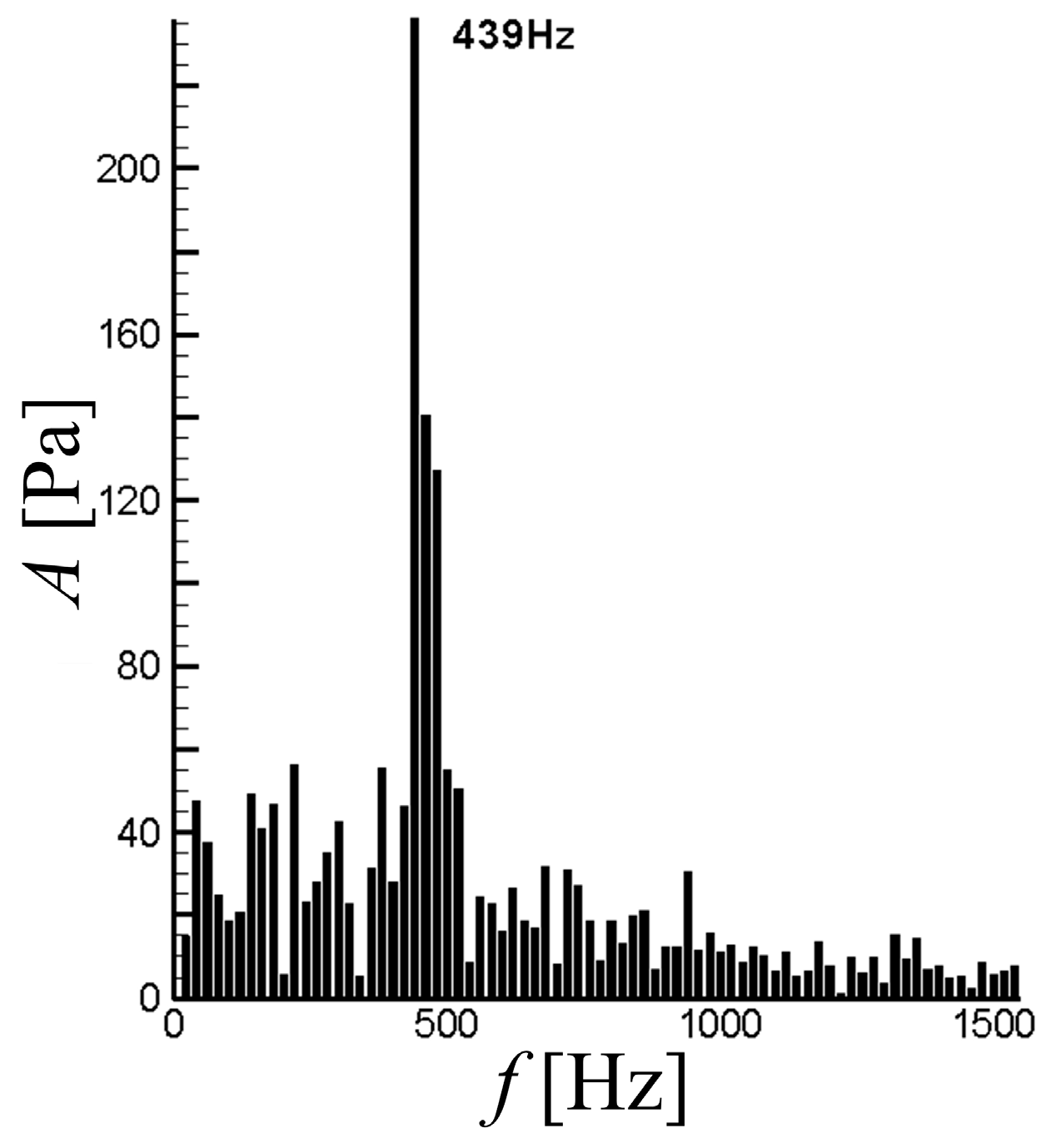

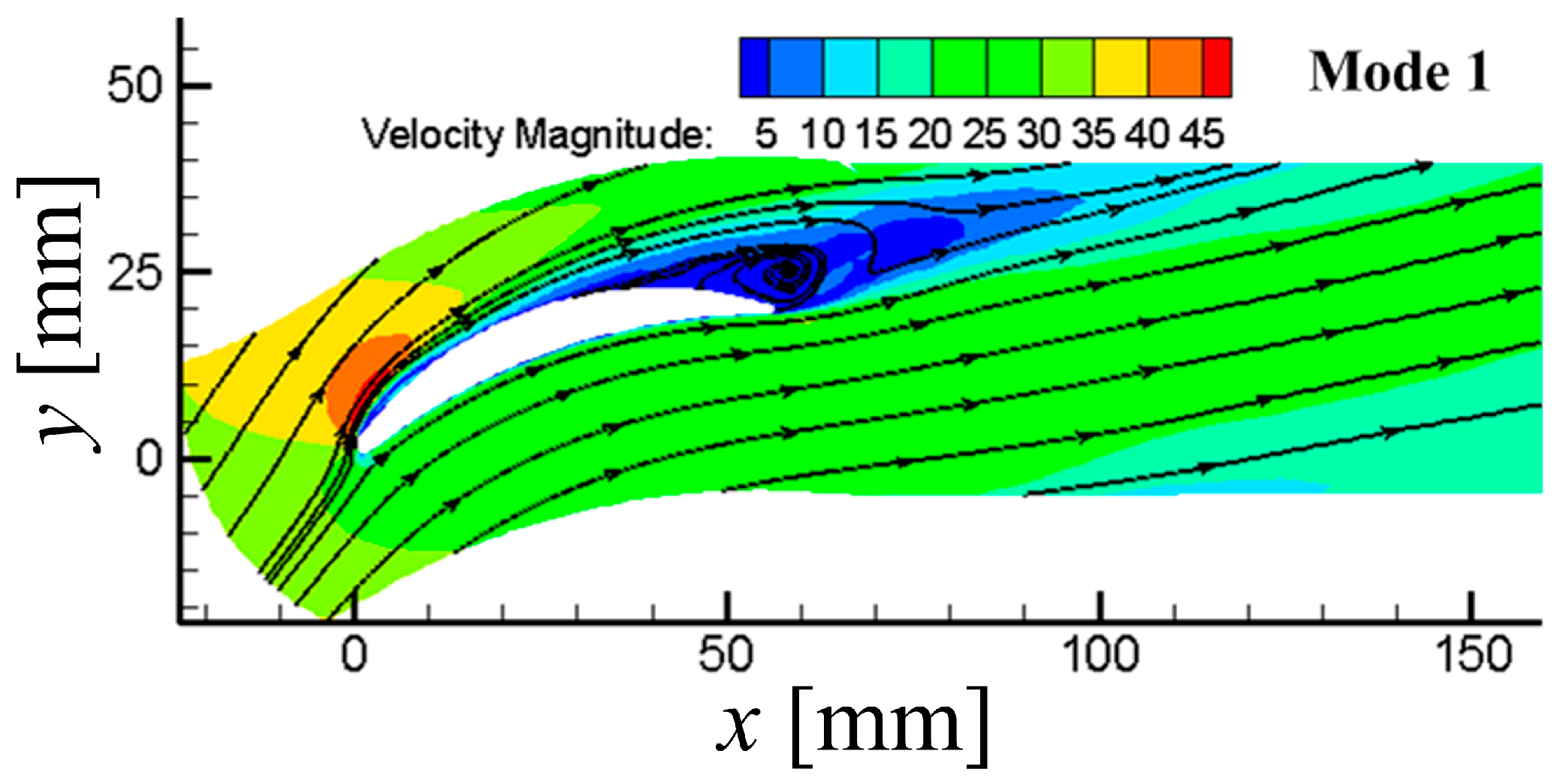
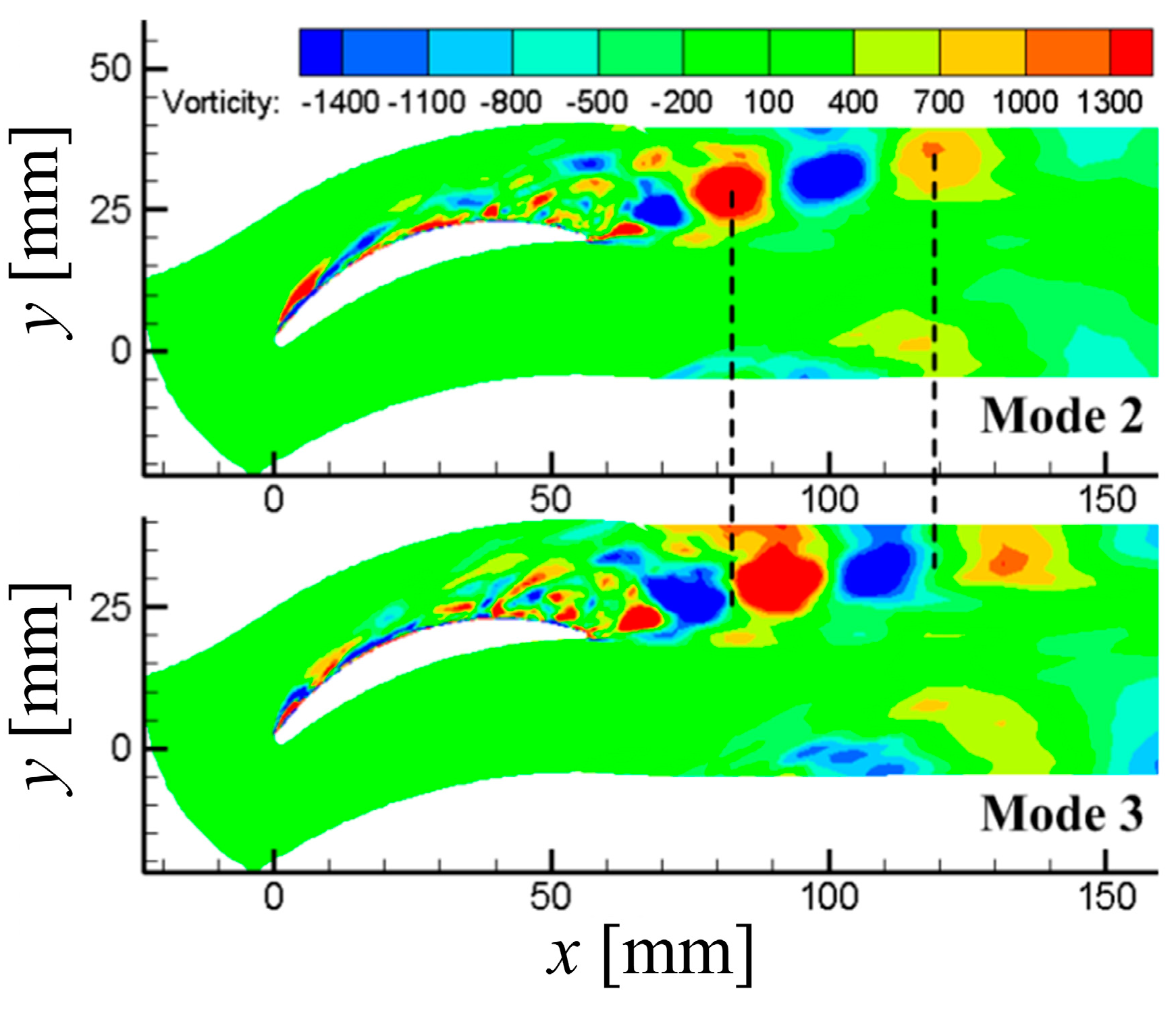
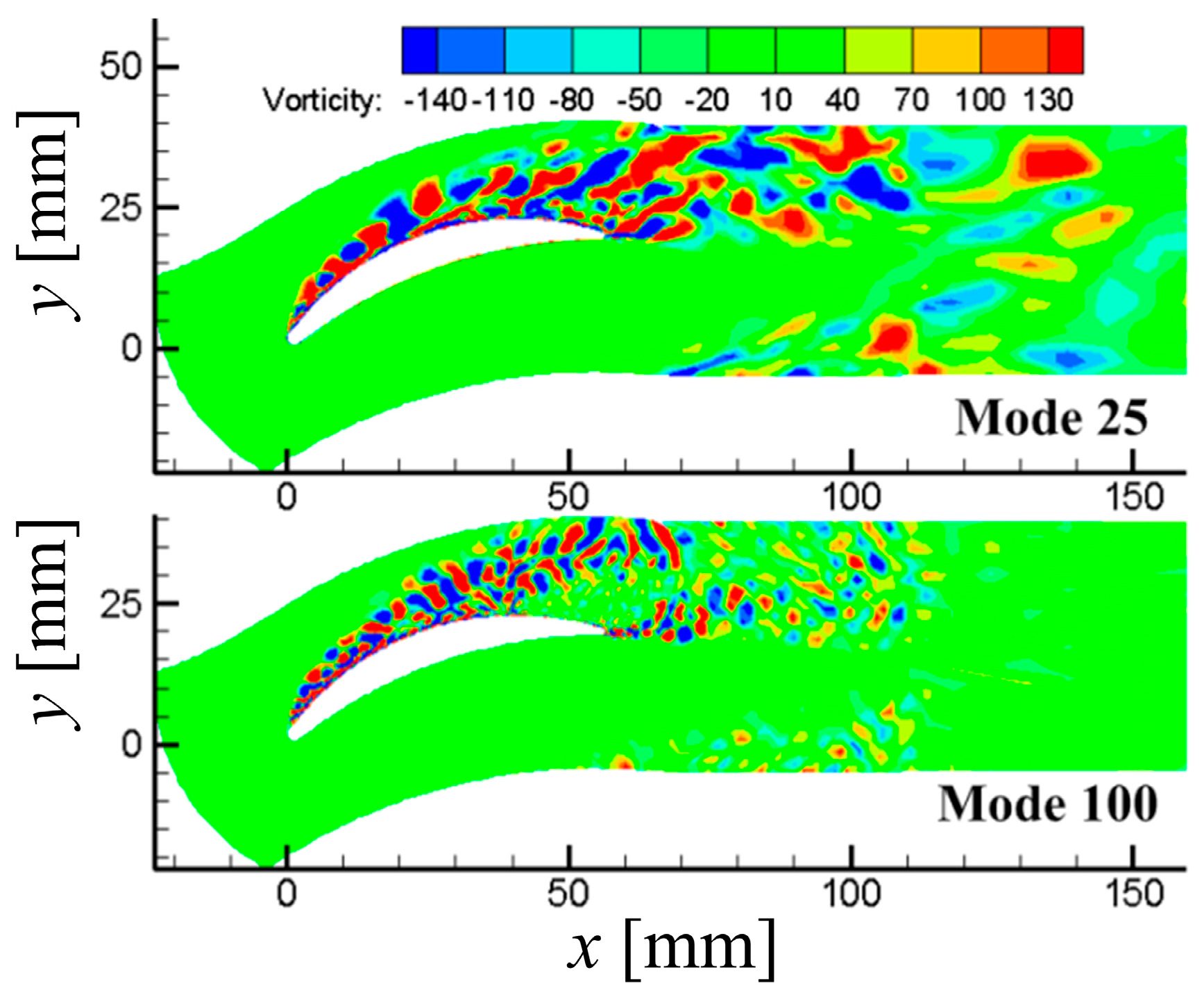
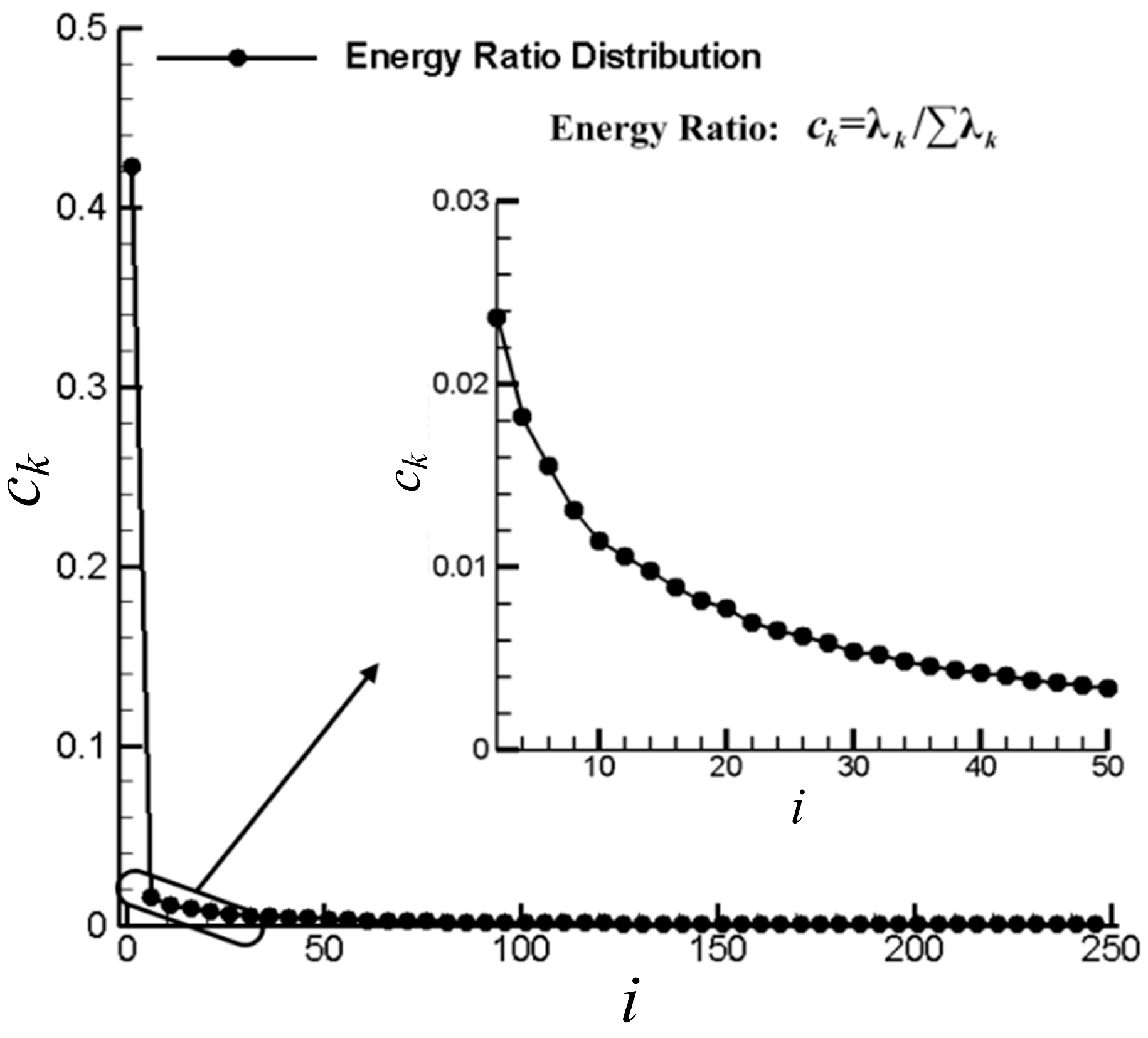
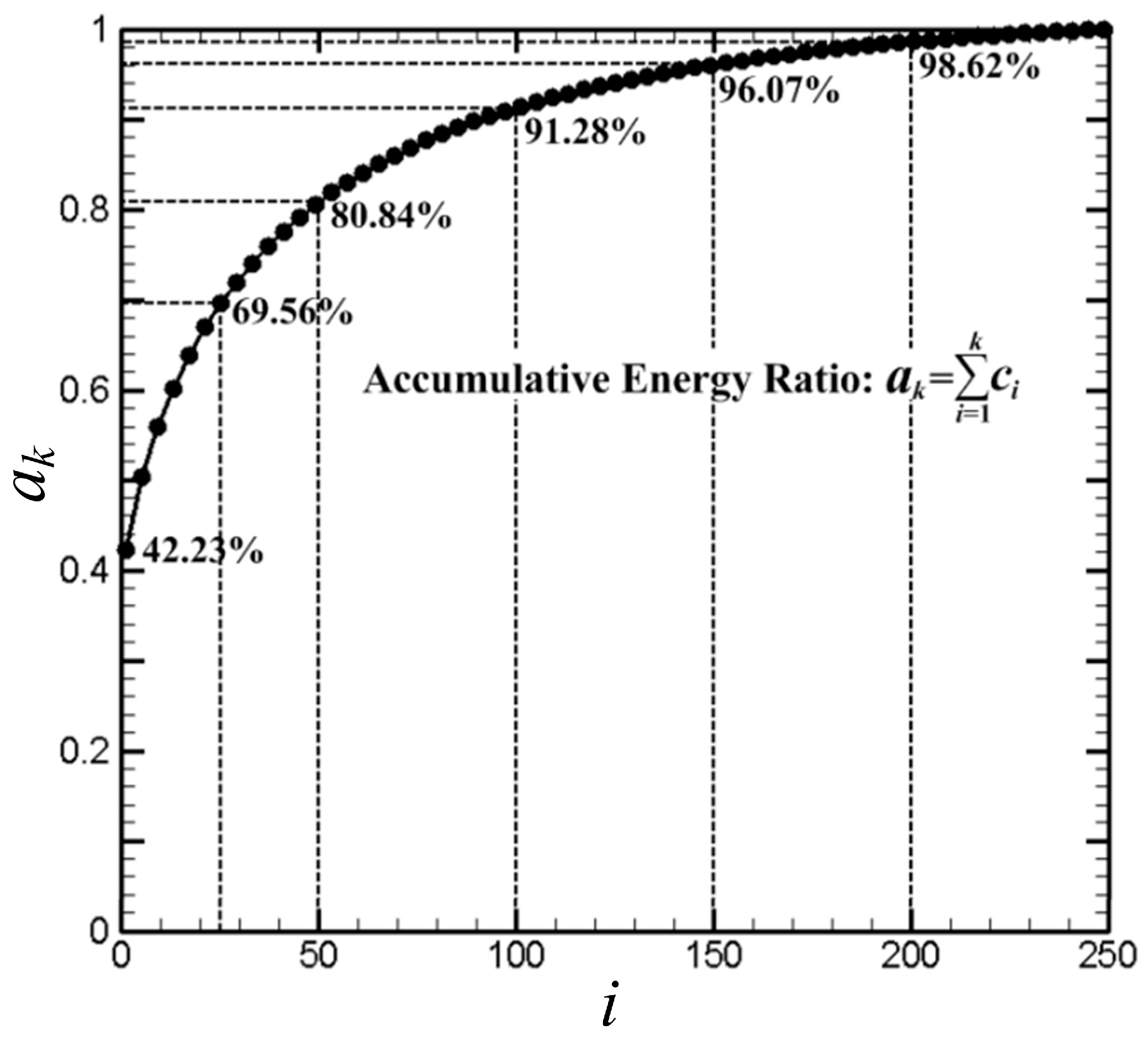
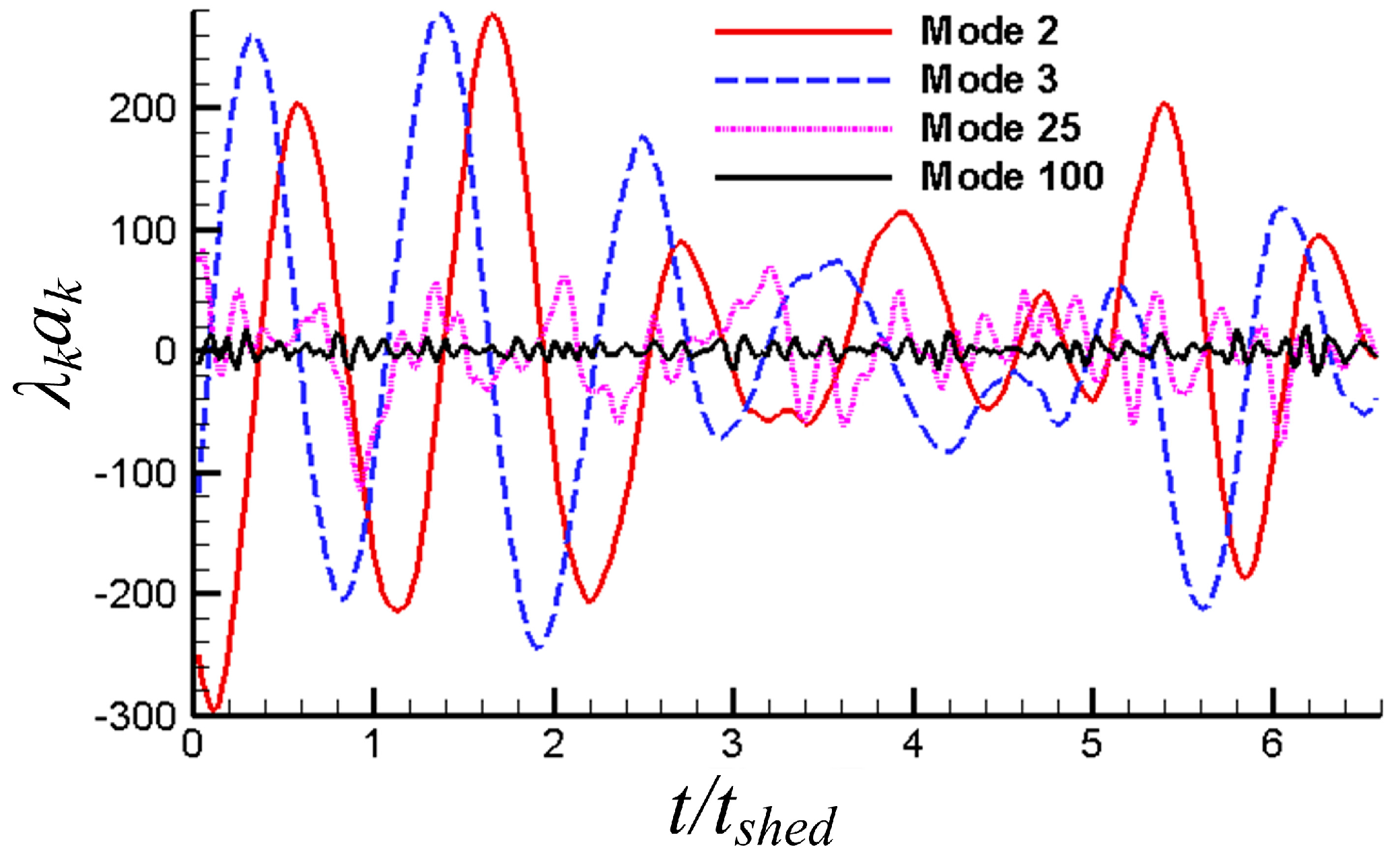


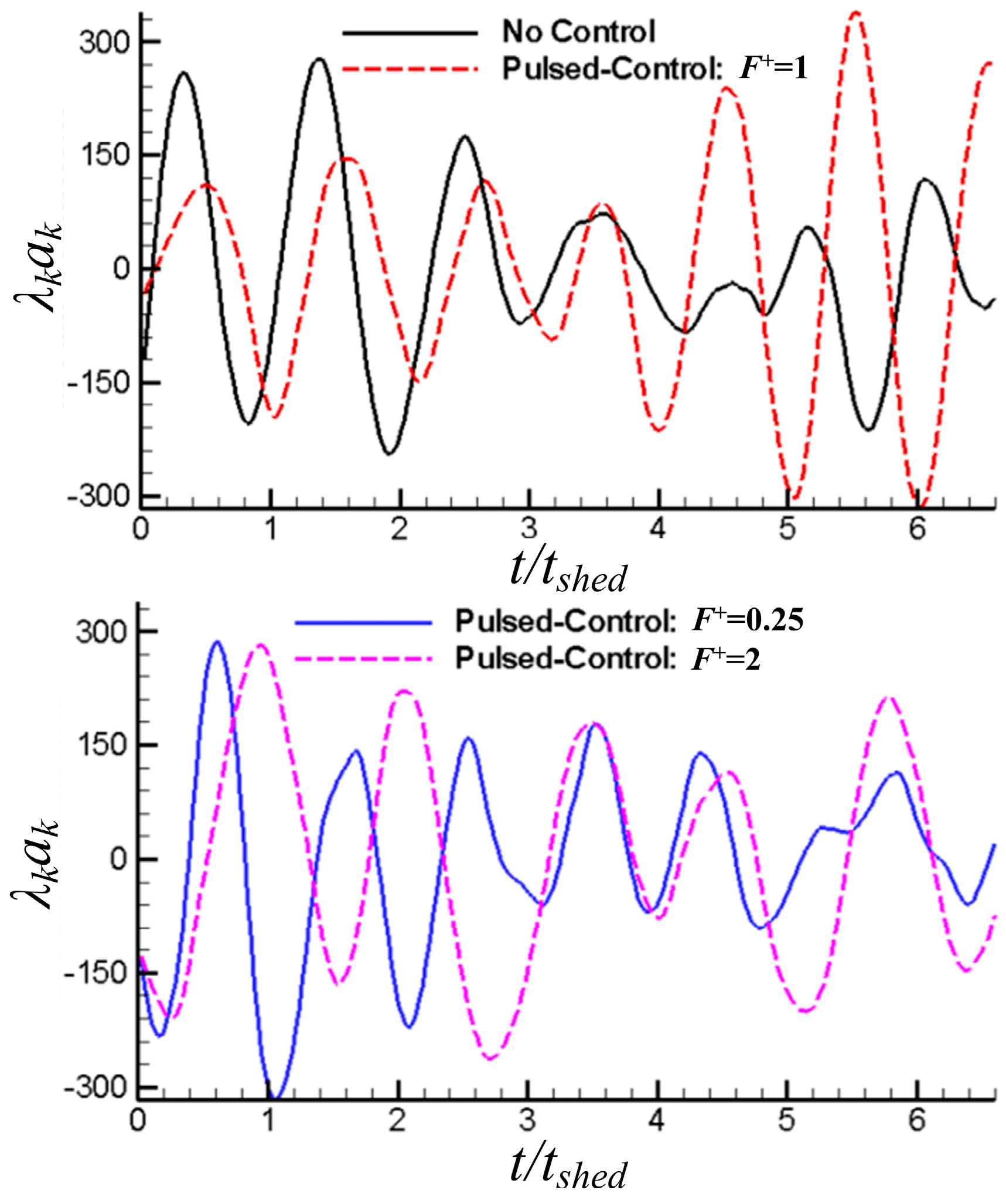
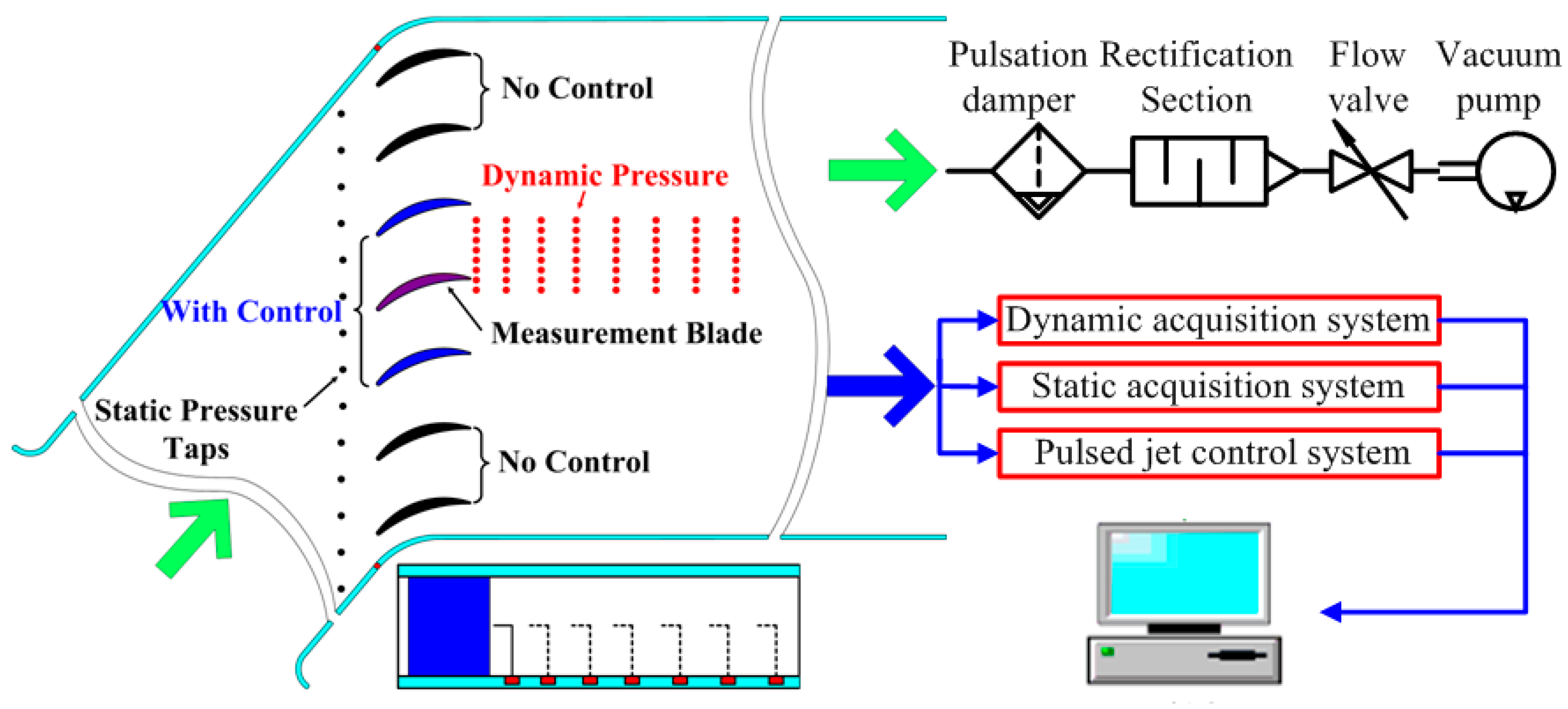

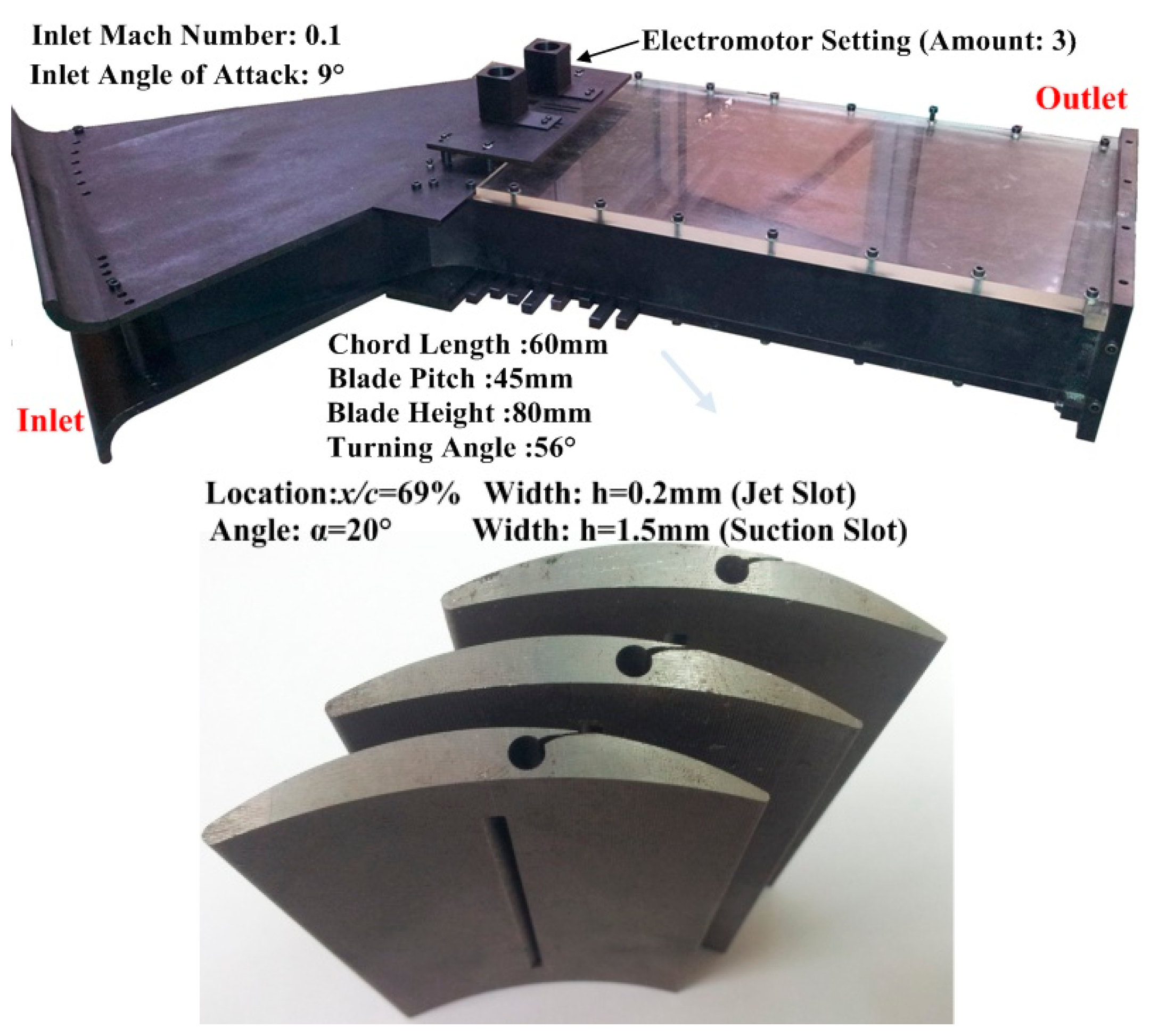
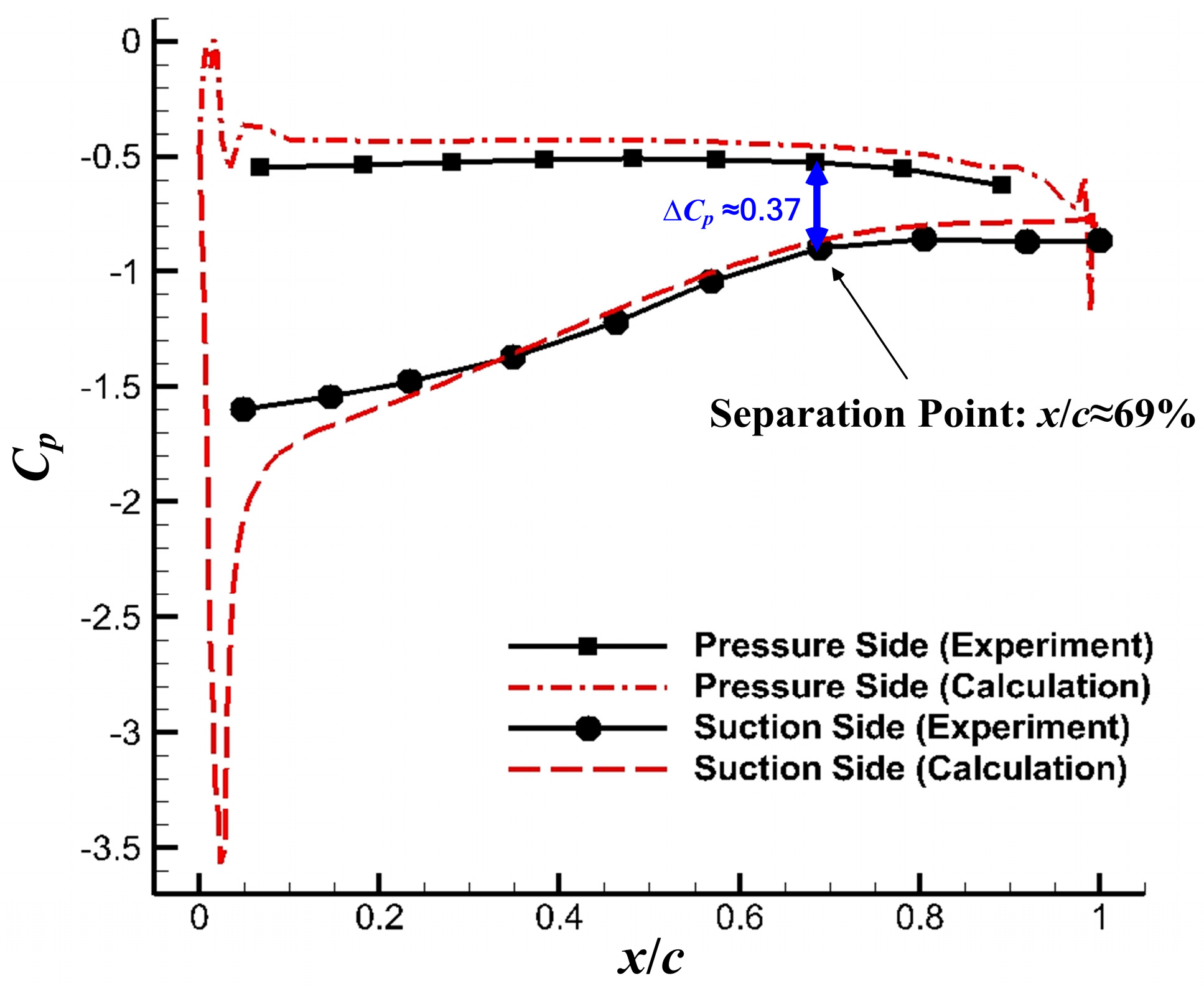
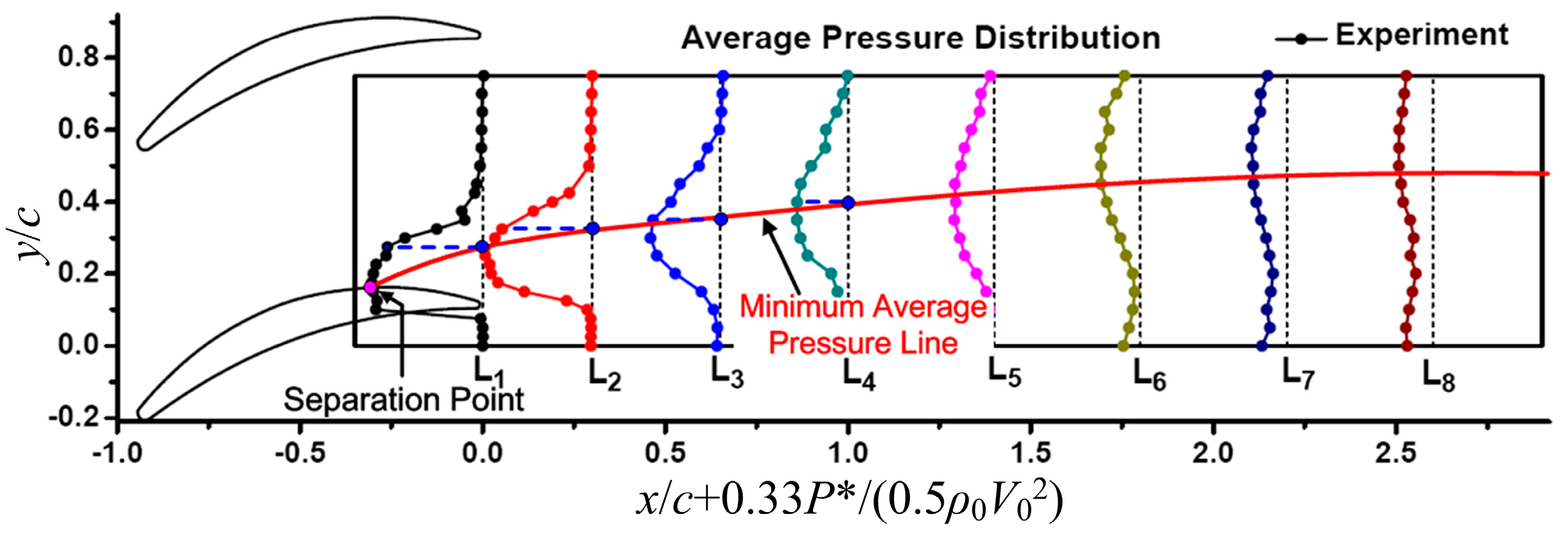
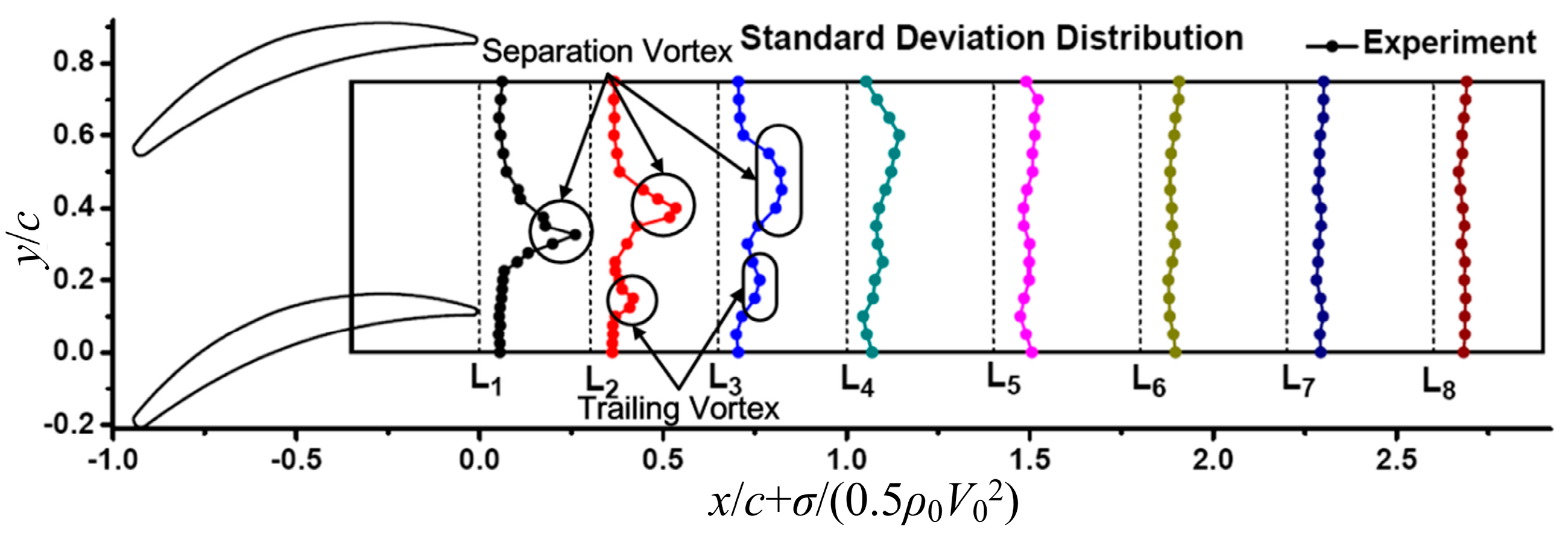
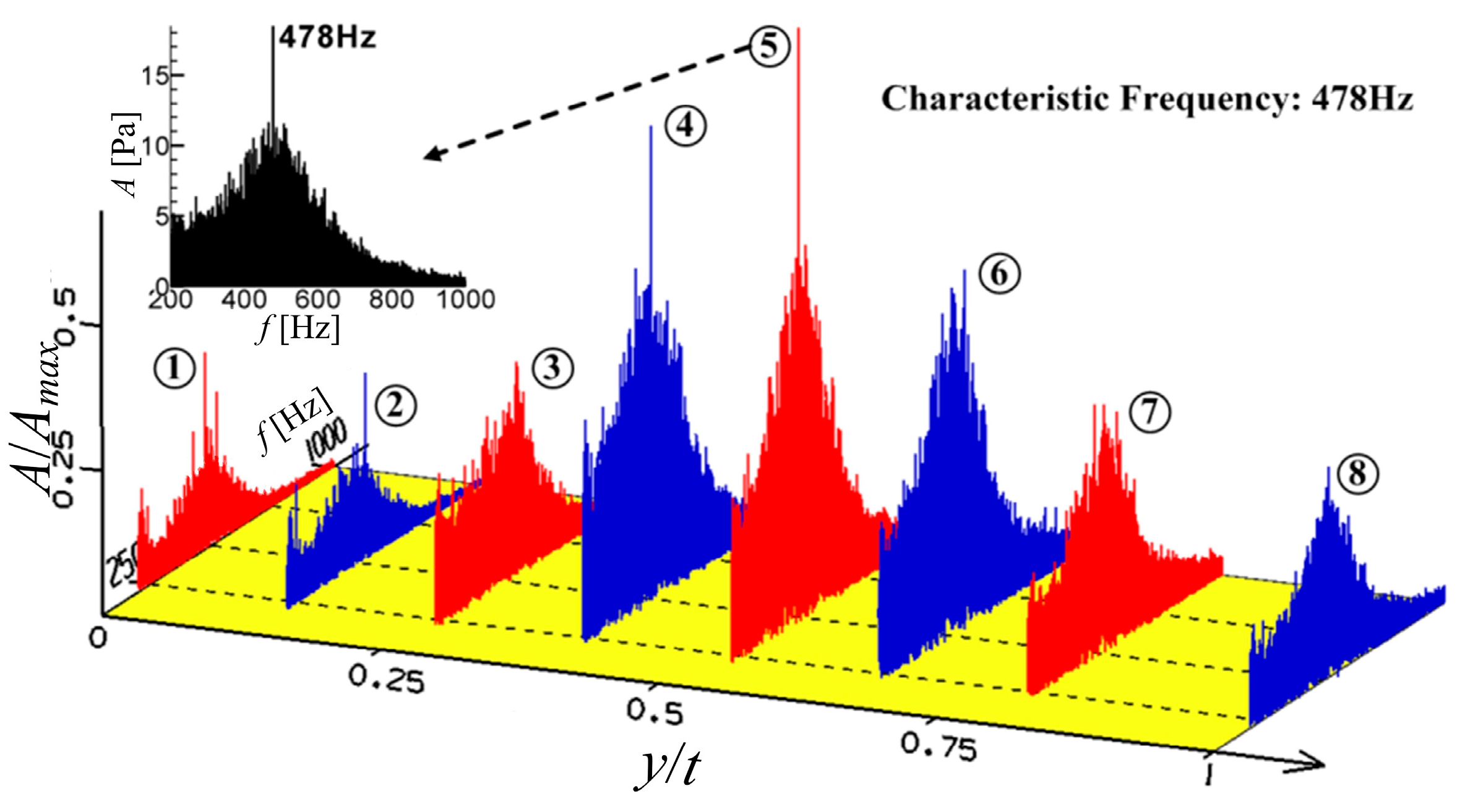
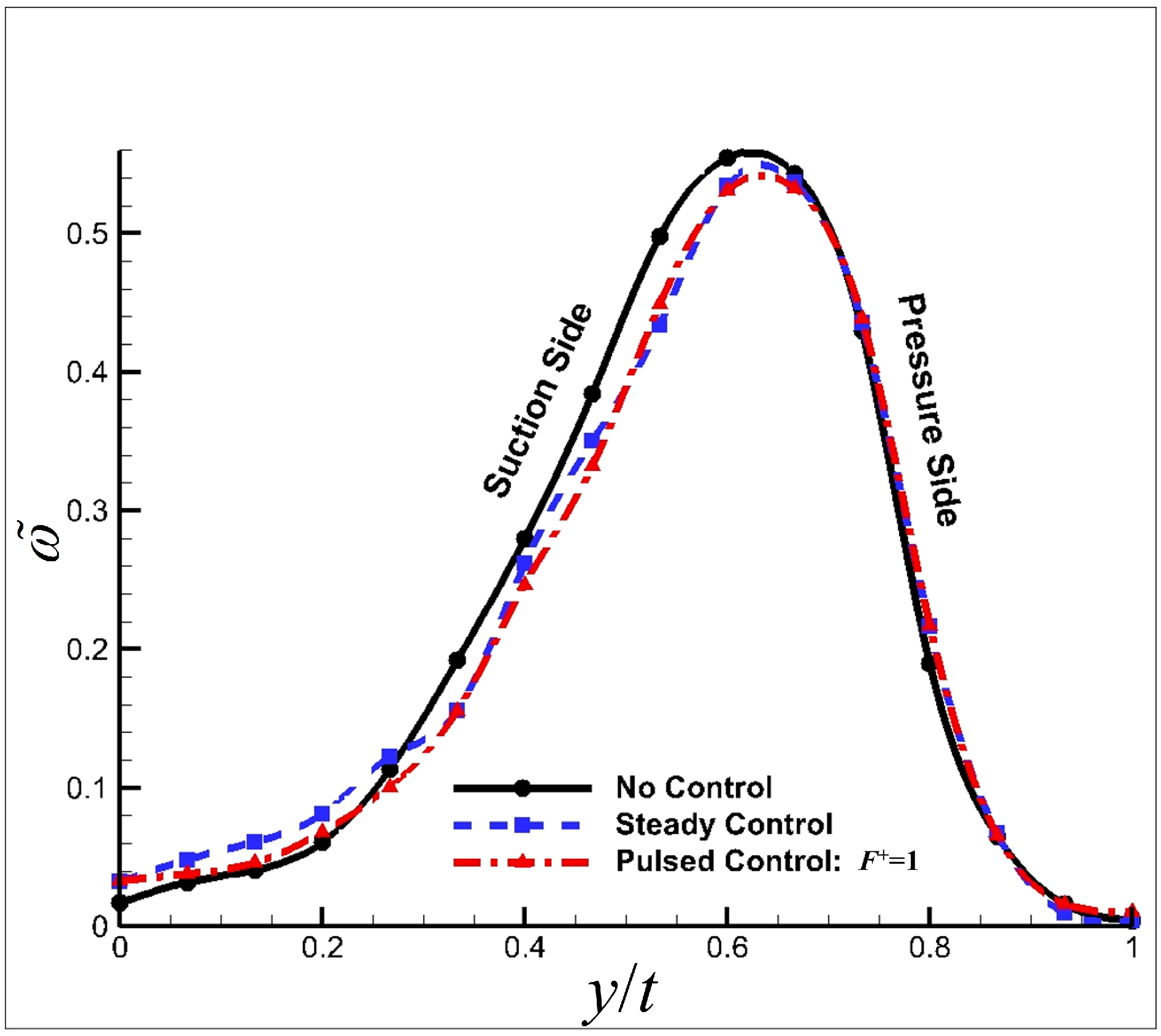
| Chord Length c/mm | Height/mm | Solidity |
|---|---|---|
| 60 | 80 | 1.333 |
| inlet blade angle/° | outlet blade angle/° | angle of attack/° |
| 46 | −10 | +9 |
| inlet mach number | inlet Reynolds number | - |
| 0.1 | 1.36 × 105 | - |
| positon of jet x/c | width of jet/mm | angle of jet/° |
| 69% | 0.2 | 20 |
© 2017 by the authors. Licensee MDPI, Basel, Switzerland. This article is an open access article distributed under the terms and conditions of the Creative Commons Attribution (CC BY) license (http://creativecommons.org/licenses/by/4.0/).
Share and Cite
Chen, J.; Lu, W.; Huang, G.; Zhu, J.; Wang, J. Research on Pulsed Jet Flow Control without External Energy in a Blade Cascade. Energies 2017, 10, 2004. https://doi.org/10.3390/en10122004
Chen J, Lu W, Huang G, Zhu J, Wang J. Research on Pulsed Jet Flow Control without External Energy in a Blade Cascade. Energies. 2017; 10(12):2004. https://doi.org/10.3390/en10122004
Chicago/Turabian StyleChen, Jie, Weiyu Lu, Guoping Huang, Jianfeng Zhu, and Jinchun Wang. 2017. "Research on Pulsed Jet Flow Control without External Energy in a Blade Cascade" Energies 10, no. 12: 2004. https://doi.org/10.3390/en10122004
APA StyleChen, J., Lu, W., Huang, G., Zhu, J., & Wang, J. (2017). Research on Pulsed Jet Flow Control without External Energy in a Blade Cascade. Energies, 10(12), 2004. https://doi.org/10.3390/en10122004






